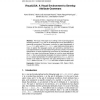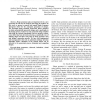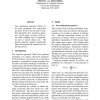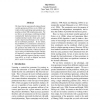167
click to vote
DCC
2011
IEEE
14 years 7 months ago
2011
IEEE
Larsson and Moffat’s RePair algorithm is generalized from strings to trees. The new algorithm (TreeRePair) produces straight-line linear context-free tree (SLT) grammars which a...
125
Voted
JMLR
2010
14 years 7 months ago
2010
Probabilistic grammars offer great flexibility in modeling discrete sequential data like natural language text. Their symbolic component is amenable to inspection by humans, while...
102
Voted
COMSIS
2010
14 years 10 months ago
2010
The focus of this paper is on crafting a new visual language for attribute grammars (AGs), and on the development of the associated programming environment. We present a solution f...
111
Voted
COMSIS
2010
14 years 10 months ago
2010
Abstract. Grammar metrics have been introduced to measure the quality and the complexity of the formal grammars. The aim of this paper is to explore the meaning of these notions an...
132
Voted
IEEECGIV
2009
IEEE
14 years 10 months ago
2009
IEEE
Shape grammars play an important role in a new generation of tools for the analysis and design of products. In this work we present a general tool named Shape Grammar Interpreter (...
107
Voted
EMNLP
2009
14 years 10 months ago
2009
This paper proposes a novel method to refine the grammars in parsing by utilizing semantic knowledge from HowNet. Based on the hierarchical state-split approach, which can refine ...
117
Voted
ACL
2009
14 years 10 months ago
2009
Tree substitution grammars (TSGs) offer many advantages over context-free grammars (CFGs), but are hard to learn. Past approaches have resorted to heuristics. In this paper, we le...
103
Voted
NAACL
2010
14 years 11 months ago
2010
We show that the automatically induced latent variable grammars of Petrov et al. (2006) vary widely in their underlying representations, depending on their EM initialization point...
116
click to vote
EMNLP
2010
14 years 11 months ago
2010
We report on investigations into hierarchical phrase-based translation grammars based on rules extracted from posterior distributions over alignments of the parallel text. Rather ...
ACL
2010
14 years 11 months ago
2010
Hierarchical A (HA) uses of a hierarchy of coarse grammars to speed up parsing without sacrificing optimality. HA prioritizes search in refined grammars using Viterbi outside cost...




